 W
WThe siege of Acre took place in 1291 and resulted in the Crusaders losing control of Acre to the Mamluks. It is considered one of the most important battles of the period. Although the crusading movement continued for several more centuries, the capture of the city marked the end of further crusades to the Levant. When Acre fell, the Crusaders lost their last major stronghold of the Crusader Kingdom of Jerusalem. They still maintained a fortress at the northern city of Tartus, engaged in some coastal raids, and attempted an incursion from the tiny island of Ruad, but when they lost that as well in 1302 in the siege of Ruad, the Crusaders no longer controlled any part of the Holy Land.
 W
WThe Siege of Acre was the first significant counterattack by Guy of Jerusalem against Saladin, leader of the Muslims in Syria and Egypt. This pivotal siege formed part of what later became known as the Third Crusade. The siege lasted from August 1189 until July 1191, in which time the city's coastal position meant the attacking Latin force were unable to fully invest the city and Saladin was unable to fully relieve it with both sides receiving supplies and resources by sea. Finally, it was a key victory for the Crusaders and a serious setback for Saladin's ambition to destroy the Crusader states.
 W
WThe siege of Antioch took place during the First Crusade in 1097 and 1098, on the crusader's way to Jerusalem through Syria. Two sieges took place in succession. The first siege, by the crusaders against the city held by the Seljuk Empire, lasted from 20 October 1097 to 3 June 1098. The second siege, of the crusader-held city by a Seljuk relieving army, lasted three weeks in June 1098. On that day was the Battle of Antioch, in which the crusaders defeated the relieving army led by Kerbogha. The crusaders then established the Principality of Antioch, ruled by Bohemond of Taranto.
 W
WThe first siege of Arsuf, originally Apollonia, took place in 1099, just after the First Crusade. It was carried out by Godfrey of Bouillon after the city failed to pay a previously agreed tribute. The attempt to capture the city failed for want of ships.
 W
WThe siege of Constantinople (1235) was a joint Bulgarian-Nicaean siege on the capital of the Latin Empire. Latin emperor John of Brienne was besieged by the Nicaean emperor John III Doukas Vatatzes and Tsar Ivan Asen II of Bulgaria. The siege remained unsuccessful.
 W
WThe siege of Constantinople in 1203 was a Crusader siege of the capital of the Byzantine Empire, in support of the deposed emperor Isaac II Angelos and his son Alexios IV Angelos. It marked the main outcome of the Fourth Crusade.
 W
WThe sack of Constantinople occurred in April 1204 and marked the culmination of the Fourth Crusade. Crusader armies captured, looted, and destroyed parts of Constantinople, then the capital of the Byzantine Empire. After the capture of the city, the Latin Empire was established and Baldwin of Flanders was crowned Emperor Baldwin I of Constantinople in the Hagia Sophia.
 W
WThe siege of Constantinople in 1260 was the failed attempt by the Nicene Empire, the major remnant of the fractured Byzantine Empire, to retake Constantinople from the Latin Empire and re-establish the City as the political, cultural and spiritual capital of a revived Byzantine Empire.
 W
WThe siege of Damascus took place between 24 and 28 July 1148, during the Second Crusade. It ended in a decisive crusader defeat and led to the disintegration of the crusade. The two main Christian forces that marched to the Holy Land in response to Pope Eugene III and Bernard of Clairvaux's call for the Second Crusade were led by Louis VII of France and Conrad III of Germany. Both faced disastrous marches across Anatolia in the months that followed, with most of their armies being destroyed. The original focus of the crusade was Edessa (Urfa), but in Jerusalem, the preferred target of King Baldwin III and the Knights Templar was Damascus. At the Council of Acre, magnates from France, Germany, and the Kingdom of Jerusalem decided to divert the crusade to Damascus.
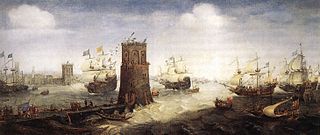 W
WThe siege of Damietta of 1218–1219 was part of the Fifth Crusade in which the Crusaders attacked the Egyptian port city of Damietta. The city, under the control of the Ayyubid sultan al-Kamil, was besieged in 1218 and taken by the Crusaders in 1219.
 W
WThe siege of Damietta occurred in 1249 and was part of the Seventh Crusade.
 W
WThe commandery of Saint-Jean-d'Acre is a monumental complex founded by the Hospitallers. It is located in the city of Saint-Jean-d'Acre. In the 13th century, the commandery became the siege of the Order of St. John of Jerusalem until the fall of the city in 1291.
 W
WThe 1244 siege of Jerusalem took place after the Sixth Crusade, when roaming Khwarazmians clans conquered the city on July 15, 1244.
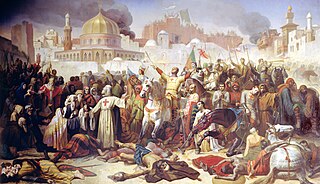 W
WThe siege of Jerusalem was waged by European forces of the First Crusade, resulting in the capture of the Holy City of Jerusalem from the Muslim Fatimid Caliphate, and laying the foundation for the Christian Kingdom of Jerusalem, which lasted almost two centuries. The capture of Jerusalem was the final major battle of the first of the Crusades to liberate and occupy the Holy Land begun in 1095. A number of eyewitness accounts of the siege were recorded, the most quoted being that from the anonymous Gesta Francorum. Upon the declaration of the secular state, Godfrey of Bouillon, prominent among the leaders of the crusades, was elected ruler, eschewing the title "king." The siege led to the mass slaughter of thousands of Muslims and Jews and to the conversion of Muslim holy sites on the Temple Mount into Christian shrines.
 W
WThe siege of Jerusalem lasted from September 20 to October 2, 1187, when Balian of Ibelin surrendered the city to Saladin. Earlier that summer, Saladin had defeated the kingdom's army and conquered several cities. The city was full of refugees and had few defenders, and it fell to the besieging armies. Balian bargained with Saladin to buy safe passage for many, and the city came into Saladin's hands with limited bloodshed. Though Jerusalem fell, it was not the end of the Kingdom of Jerusalem, as the capital shifted first to Tyre and later to Acre after the Third Crusade. Latin Christians responded in 1189 by launching the Third Crusade led by Richard the Lionheart, Philip Augustus, and Frederick Barbarossa separately. In Jerusalem, Saladin restored Muslim holy sites, became the first Custodian of the Three Holy Mosques and practiced tolerance toward Christians.
 W
WThe siege of Kerak of 1183 was an attack on the city of Kerak by the forces of Saladin on the Crusader stronghold. The siege was repelled by the Crusaders.
 W
WThe Crusader fortress of Krak des Chevaliers fell to the Mamluk sultan Baibars in 1271. Baibars went north to deal with Krak des Chevaliers after the death of Louis IX of France on 29 November 1270.
 W
WIn 1142 according to a brief reference in the Anglo-Norman text known as De expugnatione Lyxbonensi and the Portuguese text known as the Chronica Gothorum, a group of Anglo-Norman Independent crusaders on their way to Jerusalem were invited by King Afonso I Henriques of Portugal to participate in an attempt to capture the Almoravid-controlled city of Lisbon. The Anglo-Norman forces might have been led by the brothers William and Ralph Vitalus as it is implied by the De expugnatione Lyxbonensi.
 W
WThe siege of Lisbon, from 1 July to 25 October 1147, was the military action that brought the city of Lisbon under definitive Portuguese control and expelled its Moorish overlords. The siege of Lisbon was one of the few Christian victories of the Second Crusade—it was "the only success of the universal operation undertaken by the pilgrim army", i.e., the Second Crusade, according to the near contemporary historian Helmold, though others have questioned whether it was really part of that crusade. It is seen as a pivotal battle of the wider Reconquista.
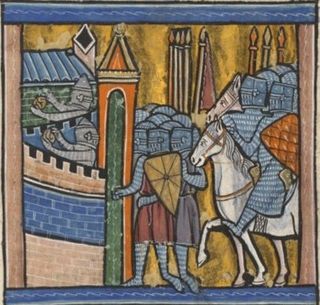 W
WThe siege of Nicaea was the first major battle of the First Crusade, taking place from 14 May to 19 June 1097. The city was under the control the Seljuk Turks who opted to surrender to the Byzantines in fear of the crusaders breaking into the city. The siege was followed by the Battle of Dorylaeum and the Siege of Antioch, all taking place in modern Turkey.
 W
WThe fall of Ruad in 1302 was one of the culminating events of the Crusades in the Eastern Mediterranean. When the garrison on the tiny Isle of Ruad fell, it marked the loss of the last Crusader outpost on the coast of the Levant. In 1291, the Crusaders had lost their main power base at the coastal city of Acre, and the Muslim Mamluks had been systematically destroying any remaining Crusader ports and fortresses since then, forcing the Crusaders to relocate their dwindling Kingdom of Jerusalem to the island of Cyprus. In 1299–1300, the Cypriots sought to retake the Syrian port city of Tortosa, by setting up a staging area on Ruad, two miles (3 km) off the coast of Tortosa. The plans were to coordinate an offensive between the forces of the Crusaders, and those of the Ilkhanate. However, though the Crusaders successfully established a bridgehead on the island, the Mongols did not arrive, and the Crusaders were forced to withdraw the bulk of their forces to Cyprus. The Knights Templar set up a permanent garrison on the island in 1300, but the Mamluks besieged and captured Ruad in 1302. With the loss of the island, the Crusaders lost their last foothold in the Holy Land. Attempts at other Crusades continued for centuries, but the Europeans were never again able to occupy any territory in the Holy Land until the 20th century, during the events of World War I.
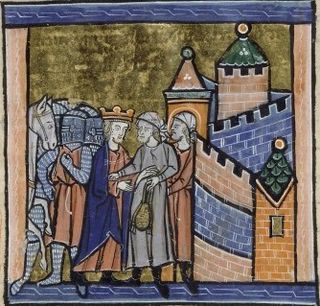 W
WThe siege of Shaizar took place from April 28 to May 21, 1138. The allied forces of the Byzantine Empire, Principality of Antioch and County of Edessa invaded Muslim Syria. Having been repulsed from their main objective, the city of Aleppo, the combined Christian armies took a number of fortified settlements by assault and finally besieged Shaizar, the capital of the Munqidhite Emirate. The siege captured the city, but failed to take the citadel; it resulted in the Emir of Shaizar paying an indemnity and becoming the vassal of the Byzantine emperor. The forces of Zengi, the greatest Muslim prince of the region, skirmished with the allied army but it was too strong for them to risk battle. The campaign underlined the limited nature of Byzantine suzerainty over the northern Crusader states and the lack of common purpose between the Latin princes and the Byzantine emperor.
 W
WA Siege of Toulouse occurred from 22 September 1217 to 25 July 1218 during the Albigensian Crusade. It was third of a series of sieges of the city during the height of Crusader efforts to put down Catharism. It ended in the repulsion of the Crusaders and the death of their leader, Simon IV de Montfort.
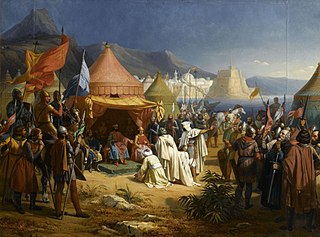 W
WThe siege of Tripoli lasted from 1102 until July 12, 1109. It took place on the site of the present day Lebanese city of Tripoli, in the aftermath of the First Crusade. It led to the establishment of the fourth crusader state, the County of Tripoli.
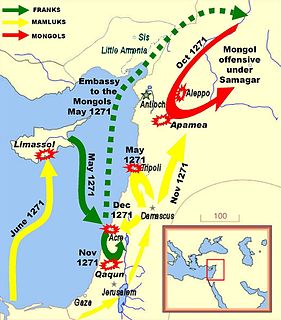 W
WThe 1271 siege of Tripoli was initiated by the Mamluk ruler Baibars against the Frankish ruler of the Principality of Antioch and the County of Tripoli, Bohemond VI. It followed the dramatic fall of Antioch in 1268, and was an attempt by the Mamluks to completely destroy the Crusader states of Antioch and Tripoli.
 W
WThe Fall of Tripoli was the capture and destruction of the Crusader state, the County of Tripoli, by the Muslim Mamluks. The battle occurred in 1289 and was an important event in the Crusades, as it marked the capture of one of the few remaining major possessions of the Crusaders. The event is represented in a rare surviving illustration from a now fragmentary manuscript known as the 'Cocharelli Codex', thought to have been created in Genoa in the 1330s. The image shows the countess Lucia, Countess of Tripoli and Bartholomew, Bishop of Tortosa sitting in state in the centre of the fortified city, and Qalawun's assault in 1289, with his army depicted massacring the inhabitants fleeing to boats in the harbour and to the nearby island of St Thomas.
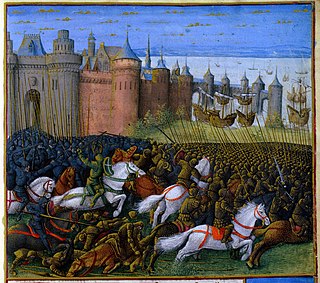 W
WThe siege of Tyre took place from 12 November 1187 to 1 January 1188. An army commanded by Saladin made an amphibious assault on the city, defended by Conrad of Montferrat. After two months of continuous struggle, Saladin dismissed his army and retreated to Acre.
 W
WThe Siege of Xerigordos in 1096, often Xerigordon in modern historical literature, pitted 6,000 Germans of the People's Crusade under Reinald of Broyes against the Turks commanded by Elchanes, general of Kilij Arslan, the Seljuk Sultan of Rûm. The crusader raiding party captured the Turkish fort of Xerigordos, about four days' march from Nicaea, in an attempt to set up a pillaging outpost. Elchanes arrived three days later and besieged the crusaders. The defenders had no water supply, and after eight days of siege, they surrendered on September 29. Some of the crusaders converted to Islam, while others who refused were killed.
 W
WThe siege of Zara or siege of Zadar was the first major action of the Fourth Crusade and the first attack against a Catholic city by Catholic crusaders. The crusaders had an agreement with Venice for transport across the sea, but the price far exceeded what they were able to pay. Venice set the condition that the crusaders help them capture Zadar, a constant battleground between Venice on one side and Croatia and Hungary on the other, whose king, Emeric, pledged himself to join the Crusade. Although some of the crusaders refused to take part in the siege, the attack on Zadar began in November 1202 despite letters from Pope Innocent III forbidding such an action and threatening excommunication. Zadar fell on 24 November and the Venetians and the crusaders sacked the city. After spending the winter in Zadar, the Fourth Crusade continued its campaign, which led to the siege of Constantinople.